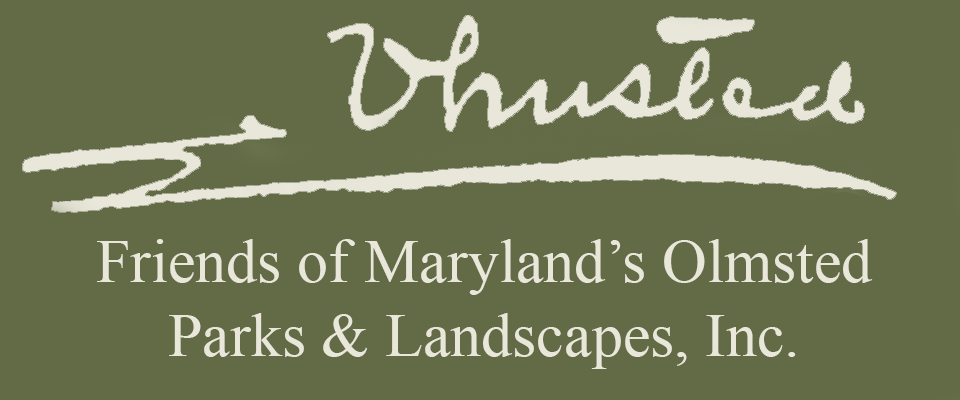The Baltimore Greenway Trails Coalition is currently undertaking a planning study for a 35-mile multi-modal trail around Baltimore that connects many of Baltimore’s parks and existing trails through a protected walking and biking trail. The Friends of Maryland’s Olmsted Parks & Landscapes (FMOPL) is a member of the coalition and has provided a letter of support for the Greenways Trail Network. In supporting the study process currently underway, FMOPL reaffirms the local Baltimore City Landmark designation for the “Olmsted Parkways,” for which it provided a leading role, and insists that all alternatives must exemplify the principles that derive from that designation.
FMOPL Position Statement:
FMOPL is committed both to 1) the preservation of Olmsted, Olmsted-inspired, and other open space resources, and 2) incorporation of pedestrian and bike infrastructure designed to current best practices. In consideration of the Greenway Trails Network planning study for the “Olmsted Parkways” route:
- FMOPL takes the position that it provides an opportunity to complete the recommendations made in the 1904 Plan to provide park-like corridors connecting the various parks and communities throughout the City;
- And that its goal of finding ways to incorporate well-designed pathways for pedestrian and bicycle use is consistent with the Olmsted vision.
- As various options are considered, whether within the median or in other forms, they must conform to the set of principles stated above. In particular, protection of the treed and green character of the designated “Olmsted Parkways” must be a major consideration.
- Ensure a defined maintenance plan for long-term sustainability of the greenway trails network.
The Case for Historic Landmark Designation:
In 1904 the Olmsted Brothers firm produced the comprehensive Report Upon the Development of Public Grounds for Greater Baltimore, which conceptualized a park system for the Baltimore region:
- called for “parkways” as East-West connectors for Baltimore’s principal parks—especially connecting Clifton Park on the east, Druid Hill Park in the center, and Gwynns Falls part on the west.
- advanced the goal that parkways “should be treated as far as possible like extensions of the parks to bring them to the people, and place them in touch with each other.” Preferably, parkways should “avoid the petty annoyances and danger of ordinary street travel . . . [and] they “should have comfortable pavements for driving, riding, and walking.” (p. 14)
- showed the proposed connector parkways as following meandering routes.
Over the next decade the Olmsteds served as consultants to the Baltimore Park Commission, which, in conjunction with the Commission on Street Openings, was responsible for the actual implementation of the parkway plans.
- Correspondence from the Olmsteds demonstrates that they urged widths to allow for parklike treatment, and a proposed sketch by Olmsted staffer P.R. Jones in 1906 suggested a multi-modal series of tree-lined corridors, providing separately for corridors to accommodate such uses as walking, riding (horseback or biking?), and a central road. However, the Baltimore authorities made it clear immediately that the recommended widths were not feasible.
- The resulting “parkways,” built by the Baltimore park and road commissions in continuing consultation with the Olmsteds, but not “designed” by them, took the form of the tree-lined central median roadways that resulted in the essential pattern that has prevailed generally for the past century.
Given that historic basis, what should land-marking mean for “the Olmsted Parkways” in relation to the planning process for the Baltimore Greenway Trails Network Proposals?
Landmark designation does not mean that no change whatsoever to what resulted from the original building of the parkway-like streets can be considered; it does mean that the following “principles” should be upheld as consistent with historic precedent:
- the “park-like” character of the parkways should be maintained and enhanced;
- any threat to the health of present or future trees should be avoided, since shade trees have been essential to maintaining the parklike character from the inception of the plans;
- the essential “green” character of the median should be maintained, and any pathways must be designed and maintained in such a way that they preserve and enhance that character.
- while Olmsted “principles” may have been relatively consistent over time, the long trajectory of Olmsted planning exhibits frequent adaptation to changing times and circumstances, even as exhibited in the reluctant acceptance of the narrower widths of the Baltimore parkways;
- re-design of these parkways to accommodate a hiking/biking pathway is consistent with models the Olmsteds proposed here and elsewhere and that other planners, past and present, have employed.
Approved by the Board of the Friends of Maryland’s Olmsted Parks & Landscapes at its meeting of June 14, 2017

Please let me know who receives posts to the blog on the FMOPL web site.